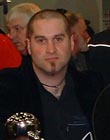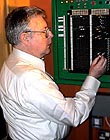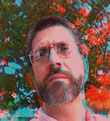|
|
This topic comprises 2 pages: 1 2
|
|
Author
|
Topic: Rear projection cinemas
|
|
|
|
|
Pete Naples
Phenomenal Film Handler

Posts: 1565
From: Dunfermline, Scotland
Registered: Feb 2001
|
 posted 04-19-2002 06:38 AM
posted 04-19-2002 06:38 AM




Howard, it can be done! There is at least one rear projection screen in the UK. Kinema in the Woods, Woodhall Spa, Lincolnshire is the only one I know of for sure. It's on the old WWII airfield that the dambusters flew from, built of nissen huts and runs Kalee projectors. Two screens, one is rear projection done just as you described, the other is front projection. Also has a working organ and organist. it's quite a place, well worth a visit, I can't remember the owners name, but he's a nice bloke and quite approachable. A colleague and I installed DOlby in both screens, the rear projection one has the LF cabs below the picture and the horns flown above, not perfect but works ok. Problems I know he has with rear projection are mirrors, you really need to use a good quality optically flat silver mirror, which are expensive and get killed by dust easily. If you use a standard bathroom mirror you lose a lot of light and sharpness. Also I noticed that the picture was quite dark towards the edges. Rear projection screens are relatively easy to come by, as rear proj is used a good deal in AV, conferencing etc.
Woodhall Spa is a lovely wee place, I stayed in a hotel near the cinema, the bar of which had been the officers mess for the dambusters squadron. The walls are covered in aeronautical memoribilia, some local enthusiasts are restoring a Lancaster bomber to flying condition, last time my colleague was there he'd seen the spectacle of it taxi'ing around on three out of four engines. That's a couple of years ago now, so it may well be flying by now.
Didn't Kalee build a reversed projector for rear projection WITHOUT the mirror??. ie The soundtrack ran on the inboard side. I'm sure somebody told me that years ago and that there were a pair running in London somewhere. Wish I could remember who told me that now!
| IP: Logged
|
|
|
|
|
|
Frank Angel
Film God

Posts: 5305
From: Brooklyn NY USA
Registered: Dec 1999
|
 posted 04-19-2002 08:39 AM
posted 04-19-2002 08:39 AM





Yes, it can be done, just like the Jerry Lewis theatres used 16mm. It can be done but with substandard results. Biggest problem is the mirrors, no, the biggest problem is the light fall off, no, it's the operating noise, no...ah -- it's everything....EVERYTHING is a big problem. First the mirrors -- they collect dust and are a chore getting aligned, almost impossible to avoid keystoning. You try to clean them and accidently nudge one a little to much and your are in alignment hell all over again. Second, forget about getting uniform screen illumination -- difficult with flat picture, absolutely impossible with scope; the light distribution characteristics of the screen material itself is that it creates a hotspot with short focal length lenses, which is what you have to use with an RS settup, The hotspot moves from left to right, depending on where you are sitting. The one theatre that used rear screen here in Brooklyn (the only one I know of and which closed in 1980) only ran flat because the scope image was so terrible. Then there's the question of sound. Projector sound -- the only thing between the projector and the audience is a huge expanse of screen material that is not at all soundproof. Unless you build a room around the projector, then it's just a noisey machine basically sitting in the same acoustical space as the audience. And then the soundtrack sound -- where do you place the speakers? Certainly not in the center of the screen so on the sides, over screen? Where ever you put them, they won't be in the ideal location, i.e., BEHIDE the screen so the audience has the illusion that the sound is coming from the image. The veteran union projectionist who ran this rear screen here told me that it was the worst place to work and it was difficult for him to get vacation relief because when any projectionist saw that theatre up on the call board, no one would sign up for it. There is a reason that there are 9000 screens in the US and none of them use a rear projecton system. It is an ill-conceived idea from the get-go any you can bet anyone opting for it will be plagued with heartburn for years to come. Why would anyone choose to do film wrong right out of the starting gate?
| IP: Logged
|
|
Bernard Tonks
Jedi Master Film Handler

Posts: 619
From: Cranleigh, Surrey, England
Registered: Apr 2001
|
 posted 04-19-2002 09:00 AM
posted 04-19-2002 09:00 AM




Pete,Cinemas in London I know that had rear projection, one was the Rank Odeon owned Palace in Tottenham, an old variety theatre, sure they were Kalee 21s with special optics without the mirror. There was the Compton Cinema Club in London's Soho with Kalee 37s facing each other behind the screen, but that was a strange set-up as I'm sure the picture was mirrored onto the front of the screen.  When the Waterloo Station News Theatre first opened, that was also a mirror system to overcome keystone, but was abandoned later in favour of raking the projectors for a direct throw. When the Waterloo Station News Theatre first opened, that was also a mirror system to overcome keystone, but was abandoned later in favour of raking the projectors for a direct throw. I have also visited the Kinema in the Woods, a must place to visit, and as Pete said, the owner Ken Green, (I believe), is very friendly indeed. Screens 2 & 3 in the old Odeon Guildford was rear projection, one with a mirror, the other direct without.
| IP: Logged
|
|
|
|
Pete Naples
Phenomenal Film Handler

Posts: 1565
From: Dunfermline, Scotland
Registered: Feb 2001
|
 posted 04-19-2002 09:59 AM
posted 04-19-2002 09:59 AM




Thanks Bernard, I had a feeling you'd know. The Waterloo news theatre rings a bell as being the place with the reversed Kalees. I must ask around and see who told me that little gem  Thanks also for remembering Ken Green's name, I had it into my head his name was Jimmy Green for some reason. Thanks also for remembering Ken Green's name, I had it into my head his name was Jimmy Green for some reason.Frank, you are the prophet of doom and gloom! For some cinemas, adding a screen, even a sub standard screen, is the difference between life and death. Projector noise need not be an issue, indeed at Kinema it isn't, as there is a booth of sorts, with a port in front of the mech. The Cameo in Edinburgh added two mini's some years abck, these were converted out of shop units to either side of the original auditoreum, and part of the back row was lost to form the cross corridor. Now those theatres have tiny pictures, you can hear the mechs as the port glass isn't too good, and the speakers are so close together you can't really tell it's stereo, but those two little boxes of 66 and 77 seats keep the place open when there's not the product to fill the main screen.
| IP: Logged
|
|
|
|
Jerry Chase
Phenomenal Film Handler

Posts: 1068
From: Margate, FL, USA
Registered: Nov 2000
|
 posted 04-19-2002 12:42 PM
posted 04-19-2002 12:42 PM




I did the math once, long ago, and found that a first surface mirror isn't going to make any major difference in standard throws - provided - that the mirror is located at least 10 feet away from the lens on short throws (60 ft or less), and further away on long throws.Greg Muller or Evans could probably do the math. I remember I was surprised at the time how little difference front and rear surface made once you got away from the lens. There is some additional light drop, but not much more than if you pushed the screen a few feet back. The big issues I've seen with rear projection are the hot spot, and sometimes a color cast from the screen material. Don't underestimate the hot spot problem on a short throw. Think of how the rays of light hitting the back of the screen are really splayed out at the edges. They will diffuse because of the screen material, but the brightest angle will always be the one directly leading through the screen to the lens. A fresnel lens screen would be the best way to reduce the problem, but the cost would be outrageous even if you could find one that large. Eliminating the fresnel possibility, there are RP screens that are much better than others through use of encapsulated spheres and other tricks. Don't even consider going with a cheap screen like frosted plastic. Folding the light path at least once to increase the throw will reduce the hot spot problem some, but that will mean more mirrors. If the bright spot is just too much of a problem, you could experiment with placing a neutral density filter a few inches in front of the lens to darken the center of the image. It is messy, a light sucker, and a kludge, but it can help.
| IP: Logged
|
|
|
|
|
|
|
|
|
|
|
|
All times are Central (GMT -6:00)
|
This topic comprises 2 pages: 1 2
|
Powered by Infopop Corporation
UBB.classicTM
6.3.1.2
The Film-Tech Forums are designed for various members related to the cinema industry to express their opinions, viewpoints and testimonials on various products, services and events based upon speculation, personal knowledge and factual information through use, therefore all views represented here allow no liability upon the publishers of this web site and the owners of said views assume no liability for any ill will resulting from these postings. The posts made here are for educational as well as entertainment purposes and as such anyone viewing this portion of the website must accept these views as statements of the author of that opinion
and agrees to release the authors from any and all liability.
|

 Home
Home
 Products
Products
 Store
Store
 Forum
Forum
 Warehouse
Warehouse
 Contact Us
Contact Us




 Printer-friendly view of this topic
Printer-friendly view of this topic











 When the Waterloo Station News Theatre first opened, that was also a mirror system to overcome keystone, but was abandoned later in favour of raking the projectors for a direct throw.
When the Waterloo Station News Theatre first opened, that was also a mirror system to overcome keystone, but was abandoned later in favour of raking the projectors for a direct throw. Thanks also for remembering Ken Green's name, I had it into my head his name was Jimmy Green for some reason.
Thanks also for remembering Ken Green's name, I had it into my head his name was Jimmy Green for some reason.








